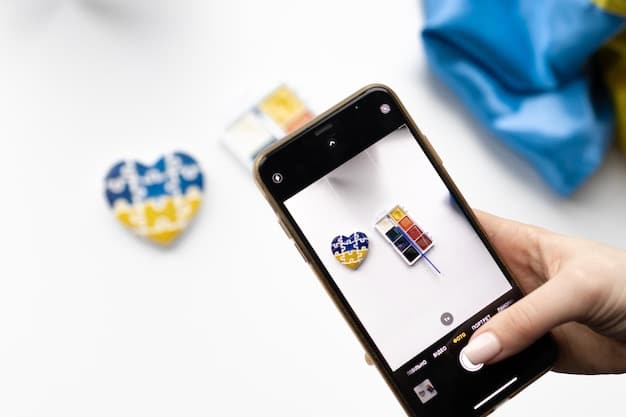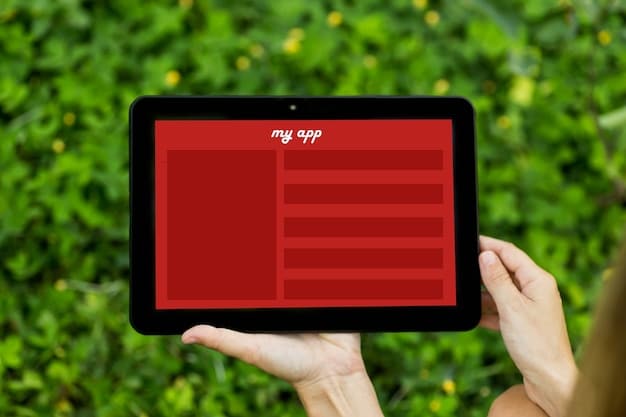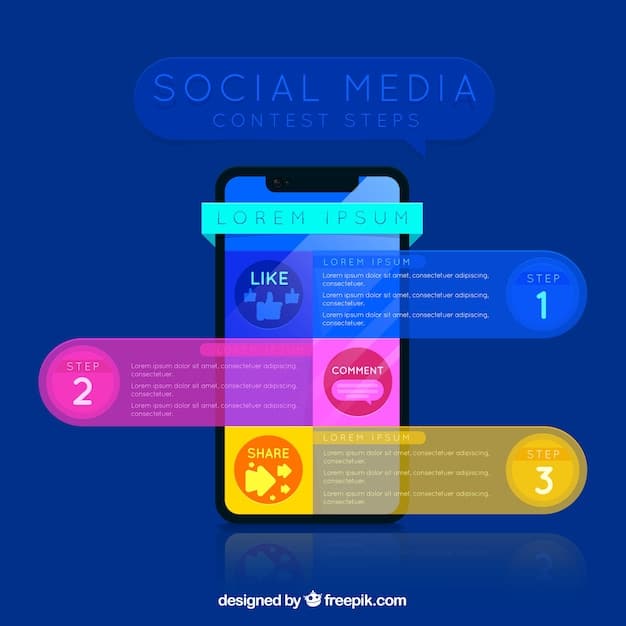Social Media Security: 5 Privacy Settings to Change Now

Elevate your social media security by adjusting five critical privacy settings; this action limits data exposure, manages ad personalization, controls location sharing, reviews app permissions, and strengthens password protection.
Is your social media privacy truly locked down? In today’s digital landscape, safeguarding your personal information is more critical than ever. Let’s explore **social media security: 5 privacy settings you should change today** to protect your digital footprint and enhance your online safety.
Understanding the Importance of Social Media Security
Social media platforms have become an integral part of our daily lives, connecting us with friends, family, and the world. However, this connectivity comes with inherent risks. Understanding the importance of social media security is the first step in protecting your personal information.
Why is social media security so crucial? Because the data you share on these platforms can be vulnerable to various threats.
Potential Risks of Inadequate Social Media Security
Without proper security measures, your social media accounts can be compromised, leading to:
- Identity Theft: Hackers can use your personal information to open fraudulent accounts or make unauthorized purchases.
- Privacy Violations: Your private photos, messages, and location data can be exposed to unwanted audiences.
- Financial Loss: Scammers can target you with phishing schemes or malware designed to steal your financial information.
- Reputational Damage: Inappropriate or malicious content can be posted on your behalf, damaging your personal or professional reputation.
Strengthening your social media security doesn’t have to be daunting. By adjusting a few key privacy settings, you can drastically reduce your risk.
Taking proactive steps to secure your social media accounts is an investment in your digital well-being. It allows you to enjoy the benefits of social media without constantly worrying about potential threats.
In conclusion, maintaining robust social media security is essential in today’s interconnected world. Understanding the potential risks associated with inadequate security measures can help you appreciate the importance of taking proactive steps to protect your accounts.
Setting Up Two-Factor Authentication (2FA)
Two-factor authentication (2FA) is one of the most effective ways to protect your social media accounts from unauthorized access. This adds an extra layer of security beyond just your password.
2FA requires you to provide two different authentication factors to verify your identity when logging in.
How Two-Factor Authentication Works
Here’s how 2FA typically works:
- You enter your username and password as usual.
- The social media platform sends a unique code to your phone via SMS or an authenticator app.
- You enter this code to complete the login process.
Even if someone manages to obtain your password, they won’t be able to access your account without this second authentication factor.
Setting up 2FA is usually a straightforward process. You can enable it in the security settings of most social media platforms. The option is very similar across all major platforms.
Always choose the most secure 2FA option available. While SMS verification is better than nothing, using an authenticator app is generally more secure.
In summary, enabling two-factor authentication is a crucial step in enhancing your social media security. By adding an extra layer of protection, you can significantly reduce the risk of unauthorized access to your accounts.
Managing Ad Personalization on Social Media
Social media platforms collect vast amounts of data about your interests, browsing history, and online behavior. This information is used to personalize the ads you see.
While personalized ads can be relevant, they also raise privacy concerns. One crucial aspect of **social media security: 5 privacy settings you should change today** is managing ad personalization.

Steps to Limit Ad Personalization
Here are some steps you can take to limit ad personalization on social media:
- Review Ad Preferences: Most platforms allow you to view and modify your ad preferences. Update these to better reflect your current interests.
- Opt-Out of Tracking: Many platforms provide options to opt-out of tracking your online activity for ad targeting purposes.
- Limit Data Collection: Adjust your privacy settings to limit the collection of data used for ad personalization.
- Use Ad Blockers: Consider using ad blockers to prevent social media platforms from tracking your browsing history and displaying personalized ads.
Managing ad personalization not only enhances your privacy but also gives you greater control over user experience.
Take the time to review your ad settings on each social media platform you use and make the necessary adjustments to limit the amount of personalized advertising that you see.
To conclude, managing ad personalization is a crucial step in safeguarding your privacy on social media. By limiting the amount of data collected about you for ad targeting purposes, you can enhance your overall online security and maintain greater control over user experience.
Controlling Location Sharing on Social Platforms
Many social media platforms request access to your location data. This allows you to tag your location in posts, find nearby friends, and receive location-based recommendations.
However, sharing your location can also pose privacy risks. To improve **social media security: 5 privacy settings you should change today**, you should carefully control location sharing on social platforms.
Why Limit Location Sharing?
Limiting location sharing can prevent:
- Stalking and Harassment: Real-time location data can be used to track your movements.
- Burglary: Criminals can use your location to determine when you’re away from your home.
- Data Breaches: Location data can be combined with other personal information to create detailed profiles.
You can manage your location sharing settings on each social media platform. Typically, you have the option to disable location services altogether or to share your location only when you choose.
Be mindful of the information you share in your posts. Avoid mentioning specific locations or travel plans that could compromise your security.
In conclusion, controlling location sharing on social media platforms is essential for protecting your privacy and safety. By limiting access to your location data, you can minimize the risk of stalking, harassment, and other privacy violations.
Reviewing Third-Party App Permissions
Many social media platforms allow you to connect third-party apps to your account. These apps can access your profile information, contacts, and other data.
However, granting excessive permissions to third-party apps can expose your data to unnecessary risks. A vital component of **social media security: 5 privacy settings you should change today** is periodically reviewing third-party app permissions.

How to Review and Revoke App Permissions
Follow these steps to review and revoke app permissions:
- Access App Settings: Go to the app settings or connected apps section of your social media account.
- Review Permissions: Check which apps have access to your account and what permissions they’ve been granted.
- Revoke Unnecessary Permissions: Remove permissions that seem excessive or unnecessary for the app to function.
- Remove Suspicious Apps: If you encounter any apps that you don’t recognize or that seem suspicious, revoke their access immediately.
By regularly reviewing and revoking app permissions, you can minimize the risk of data breaches and protect your account from unauthorized access.
Take the time to audit your app permissions on a regular basis. It’s a small effort that can make a big difference in securing your social media accounts.
In summary, reviewing third-party app permissions is a crucial step in maintaining **social media security: 5 privacy settings you should change today**. By carefully managing the apps that have access to your account, you can minimize the risk of data breaches and protect your personal information.
Strengthening Your Social Media Passwords
Your password is the first line of defense against unauthorized access to your social media accounts. Using strong, unique passwords is essential for **social media security: 5 privacy settings you should change today**.
A strong password should be:
- At least 12 characters long
- A combination of uppercase and lowercase letters
- Include numbers and symbols
- Not easily guessable, such as your name or birthday
Password Management Tips
Here are some additional tips for managing your social media passwords:
- Use a Password Manager: A password manager can generate and store strong, unique passwords for all your accounts.
- Avoid Reusing Passwords: Don’t use the same password for multiple accounts. If one account is compromised, all your other accounts could be at risk.
- Update Passwords Regularly: Change your passwords every few months to prevent unauthorized access.
If you’re having trouble coming up with new passwords, use a password generator tool.
In conclusion, strengthening your social media passwords is a fundamental step in securing your accounts. By using strong, unique passwords and following good password management practices, you can significantly reduce the risk of unauthorized access and protect your personal information. This is a huge element of **social media security: 5 privacy settings you should change today**.
| Key Aspect | Brief Description |
|---|---|
| 🔑 Two-Factor Authentication | Enable 2FA for an extra layer of security by requiring a second verification method. |
| 📣 Ad Personalization | Limit ad personalization to control data collection and improve privacy. |
| 📍 Location Sharing | Manage location sharing to prevent stalking and data breaches by limiting access to your real-time location. |
| 🛡️ App Permissions | Review and revoke unnecessary app permissions to prevent unauthorized access to your data. |
Frequently Asked Questions (FAQs)
▼
Two-factor authentication adds an extra layer of security by requiring a second verification method, making it significantly harder for hackers to access your account, even if they know your password.
▼
You can limit ad personalization by reviewing your ad preferences, opting out of tracking, and adjusting your privacy settings to control the collection of data used for ad targeting.
▼
Sharing your location can lead to stalking, harassment, and burglary, as criminals can use your location data to track your movements and determine when you are away from home.
▼
It is recommended to review third-party app permissions regularly, ideally every few months, to ensure that no unauthorized apps have access to your account and data.
▼
A strong password is the first line of defense against unauthorized access. It should be long, complex, and unique to prevent hackers from easily guessing it or gaining access through other compromised accounts.
Conclusion
Protecting your social media accounts is an ongoing process that requires vigilance and proactive measures. By implementing the five privacy settings discussed, you can significantly enhance your social media security and safeguard your personal information from potential threats. Regularly reviewing and updating these settings will ensure that you stay one step ahead of potential security breaches.





